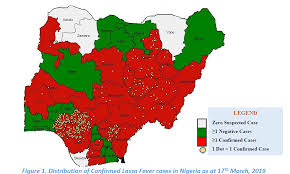The emergency phase of the 2020 Lassa fever outbreak has been declared over by the Nigeria Centre for Disease Control (NCDC).
The announcement was made following a successive decline in cases below the emergency threshold, and an epidemiological review carried out by it (NCDC) and the World Health Organisation (WHO).
A national Lassa fever Emergency Operations Centre (EOC) was activated by the NCDC on January 24, 2020.
979 confirmed cases and 188 deaths have been recorded from 27 States including the Federal Capital Territory as of April 19, 2020.
NCDC said in its statement: “It is important to highlight that this year, there was a decline in case fatality of Lassa fever, from 23% in 2019 to 19% in 2020. Despite the end of the emergency phase of this outbreak, the NCDC will continue to coordinate the national multisectoral Lassa fever Technical Working Group (TWG).
“This TWG ensures continuous monitoring of cases, as well as strengthening of Lassa fever surveillance, diagnostic, treatment and other response activities across all levels in Nigeria.”
The health agency has centered its strategic response on five key priorities:
1. Improved preparedness through training of health workers across the country and a nationwide communications campaign before the outbreak
2. Early deployment of One-Health Rapid Response Teams to affected States and deployment of surge staff to treatment centres
3. Establishment of new treatment centres and strengthening of existing treatment centres
4. Distribution of medical, laboratory, treatment and infection prevention and control supplies to all states with confirmed cases
5. Implementation of Lassa fever Environmental response campaign in high burden states by the Federal Ministry of Environment
Lassa fever is a viral haemorrhagic fever that is transmitted to humans via contact with food or household items contaminated with rodent urine or faeces. Secondary human-to-human transmission can also occur through direct contact with the blood, secretions, organs or other body fluids of infected persons, especially in health care settings.
About 80% of persons infected with the Lassa virus are asymptomatic but in the remaining 20%, the illness manifests as a febrile illness of variable severity associated with multiple organ dysfunctions with or without haemorrhage. The overall case fatality ratio is usually between 1% and 15% among patients hospitalized with severe illness. Early supportive care with rehydration and symptomatic treatment improves survival.
At least one case of Lassa fever has been detected in 27 states across 127 local government areas in the country. The predominant age-group affected is 21-30 years.
Edo has recorded the highest number of cases with 320, followed by Ondo (313), Ebonyi (73), and Taraba (56). Ondo has recorded the highest number of deaths with a total of 44 casualties, followed by Edo with 39, Taraba with 21, and Ebonyi with 16.
Other states affected are Abia, Adamawa, Anambra, Bauchi, Benue, Borno, Delta, Enugu, FCT, Gombe, Kaduna, Kano, Katsina, Kebbi, Kogi, Lagos, Nasarawa, Ogun, Osun, Oyo, Plateau, Rivers, and Sokoto.
Lagos, Ogun, Osun, and Oyo have recorded confirmed cases, but zero deaths this year.

